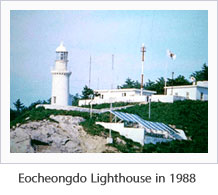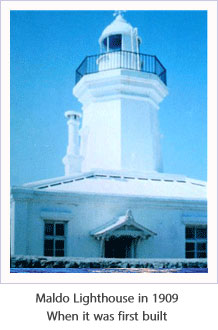MARITIME AFFAIRS SAFETY FACILITIES
Timeline of modern navigational beacons in Korea

Since the Three Kingdoms era up until the late Joseon Dynasty, our ancestors also used torches, signal fires, kkwaenggwari (small gong), flags etc. as navigational aids for ships. According to the King Sejong chronicles (1422), which is the first written record for navigational aids in Korea, a local minister placed a guide vessel in the coastal waters of Gaeudo-ri, Geunheung-myeon, Taean-gun, Chungcheongnam-do to ensure safe passage of ships carrying grain collected as tax to the government.
The introduction of modern lighthouses began with the peace treaty between the Joseon Dynasty and Japan in the year Byeongja (1876) at a time when Western Powers and Japan were vying to acquire colonies in the East. After the peace treaty with Japan, Joseon established diplomatic relations with Western Powers including the United States of America. This brought merchant vessels and battleships from various countries into our waters and demanded port facilities and navigational aids from our government on a number of occasions.

In particular, much like how they were forced into a trade treaty with the United Kingdom in 1866 after signing a peace treaty, Japan demanded the Joseon government sign the 「Joseon-Japan Trade Treaty」 on July 25, 1883. The Treaty stipulated that the 「Joseon government must repair each trade port and install lighthouse and navigational markers」, which was ultimately a part of its preparations for war against the Qing Dynasty.
A reorganized government structure in 1884 into a system with 4 departments and 8 public offices, Clerical work on shipping
and navigational aids』 became the responsibility of the 「Public Office for Government Affairs and Government Vessels」. From June to September 1895, Japan prepared and submitted a business plan to search for 30 sites along the coast of the Korean peninsular to install navigational aids. Subsequently, our government sent diplomatic documents to notify the United States and 7 other countries on the 26th of March 1902 of this plan, and construction of Palmido?Sowolmido lighthouses and Bukjangjaseo?Baekam light beacons at Incheon Port started in May 1902. On June 1, 1903, the Palmido lighthouse?Sowolmido lighthouse?Bukjangjaseo light beacon?Baekam light beacon were lighted for the first time which marked the beginning of the modern age for navigational aids in Korea. Afterwards, a total of 20 manned lighthouses and 153 unmanned light beacons including Budo lighthouse at Incheon Port, Geomundo lighthouse at Yeosu Port, Ulgi lighthouse at Ulsan Port, and Udo lighthouse at Jeju Port, Chilbaldo lighthouse at Mokpo Port were erected until the Japanese occupation began (August 1910).
After the Japanese occupation, the number of navigational aids along the coast of Korea increased and the development of equipment saw petroleum gas lamps being replaced with acetylene gas lamps. In order to ship goods for its expansion into continental Asia, Japan focused on bolstering navigational aids facilities. In particular, navigational aids facilities were used as military facilities during World War 2, and therefore destruction of these facilities was unavoidable despite navigational aids being accepted internationally as public facilities. Furthermore, when Japan lost the Pacific War and was forced to withdraw from the peninsula and Korea gained independence on August 15, 1945, retreating Japanese forces destroyed a large number of navigational aids. Only 20% of all navigational aids installed in Korea were available for use at the time. The Supreme Commander for the Allied Powers (SCAP) ordered the Japanese government to return all navigational aids on the coast of Korea to the original state prior to August 15. Japan, however, merely installed temporary lanterns off the coast of Incheon, barely adequate for US vessels to use, and reassigned lighthouse caretakers.

However, December 26, 1945 served as a turning point when Japan handed over the navigational aids duty to Korea - therefore giving our government the responsibility of providing navigational aids. The US army military government in Korea resulted in social confusion and this included the theft of goods used as navigational aids. Amidst all the confusion, the Coast Guard was created on June 15, 1946 and the importance of navigational aids in national defense was brought forward. As a result, the responsibility of providing navigational aid was transferred to the Coast Guard and supervised by the Navy. Upon the establishment of the Korean government in August 1949, operations involved in providing navigational aids were transferred to the Maritime Transportation Bureau under the Ministry of Transportation on November 4 based on Presidential Decree no. 26, and our government invested resources to repair existing navigational aids that had suffered damage. The Ministry of Transportation took over 6 lighting facilities, 2 non-signal facilities, 4 lighting beacons, 10 caretaker barracks and 10 supply vessels and began restoration works. Also, the Ministry focused on training technicians over a short period of time and maintaining facilities.

However, the unanticipated Korean War on the 25th of June destroyed most navigational aids and all efforts came to naught. The ability to provide navigational aid suffered from not only the cataclysm of war but also the supply shortage of navigational aids components and technicians. Hence the visibility of light decreased compared to even before independence on the 15th of August. As such, the Ministry of Transportation established 4 successive restoration plans between 1953 and 1960 and strived to secure the necessary technology.It was during these times, efforts were focused on installing lighthouse lanterns and restoring power. Power generation facilities were installed at 13 manned lighthouses and light sources of 29 manned lighthouses were upgraded from petroleum gas incandescent lamps to electrical lamps.
Since 1961, the implementation of successive 5 year economic development plans and the increased number of vessels saw the government focus on enlarging and improving navigational aids facilities. As a result, the number of navigational aids increased from 254 in 1960 to 418 in 1969.
The navigational aids base depot became an independent organization for the first time under the Ministry of Transport on October 2, 1961. On January 6, 1962, the manufacture of various signalling equipment for independent navigational aids facilities under direct supervision of the Minister of Transportation began. Development of equipment and the electronic movement in equipment saw navigational aids evolve into electronic devices.
The development of cutting-edge technology since the 1970s upgraded light sources to electronic lanterns, and the establishment of the Korea Maritime and Port Administration on March 13, 1976 brought numerous improvements to navigational aids facilities. In 1988, a long range navigation system ? Loran-C ? which sent out electronic signals to measure location was introduced. In 1992, modern automatic remote monitoring?control devices were installed in the Gyeokryeolbido lighthouse for the first time which aimed to remote control and monitor the operational status of navigational aids installed in lighthouses such as lanterns, non-signal devices, and power supplies using a computer. Subsequently, the number of lighthouses in remote islands and areas, that were previously manned facilities, were transformed and increased into unmanned remote controlled facilities. On August 8, 1996, the Ministry of Maritime Affairs and Fisheries was launched and given the responsibility of managing navigational aids. This provided the turning point for Korea to develop into an advanced nation in providing navigational aids. Following the introduction of the Digital Global Positioning System (DGPS) using satellites to provide accurate locational information in August 1999, the system was installed in 11 key lighthouses across the eastern?southern coast beginning with the Palmido lighthouse in the Yellow Sea in October 2002. Furthermore, a Maritime Traffic Measurement Ship was built in October 25, 2000 to collect and analyze information in providing navigational aid services. Then a comprehensive maritime traffic management information system that combines the Integrated Maritime Traffic Management System that offers real-time maritime traffic information including navigational aids management and operation relevant to navigational safety in coastal waters excluding ports, the Current Signal Station to provide real-time information to seafarers on currents in waters with strong currents, and Weather Signal Aids to provide local weather forecasts and information with information technology, were introduced.
These efforts are aimed at understanding current information regarding the integrated management of maritime traffic safety facilities and vessels entering and exiting ports in real time to prevent maritime accidents and contribute to protecting the lives of people working at sea and their property.

In the future, increased shipping volume and the ever growing size and speed of vessels will induce change in the maritime traffic environment. Therefore the importance of navigational aids equipped with cutting-edge technology to prevent maritime accidents and to ensure the safe passage of vessels will grow even further. Also, in order to manage lighthouses with historical value efficiently and utilize them as forward bases in creating marine waterfront cultural areas, and to inspire an appreciation of the maritime environment among the public and provide a place to experience maritime culture, the Korean
government has been operating 3 lodgings open to the public since 2000. Furthermore, to preserve navigational aids and equipment which are disappearing into the history books, to leave these articles to the next generation, and to cultivate the importance of maritime traffic safety and love for the ocean, the only Lighthouse Museum in Korea was opened on February 7, 1985 in Homigot, Pohang-si, Gyeongsangbuk-do. Celebrating the centenary of lighthouses in Korea, a place to exhibit artifacts from the past and provide an opportunity to experience maritime culture, preserve the history of navigational aids, and conduct research and development, the government has started planning for an expansion project to create a secondary exhibition hall, additional facilities, and improve displayed articles since 1996. These efforts came to fruition on the 19th of April 2002 when the Lighthouse Museum was re-opened to the public.
Roughly 100 years have passed since the first lighthouse shined a ray of light across the dark sea to show the way for ships. Since then, navigational aids have improved leaps and bounds. The 21st century is the new maritime age. It is our precious right and obligation to keep improving our navigational aids and create a stronger, happier country.

